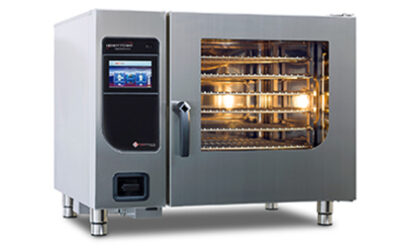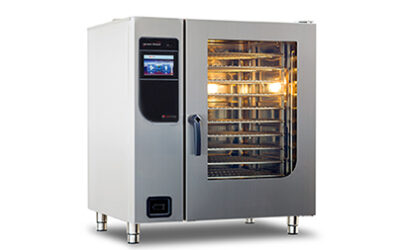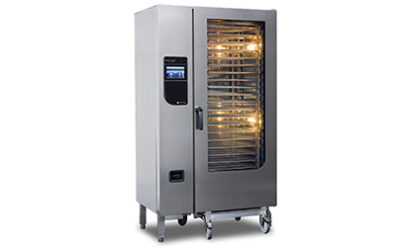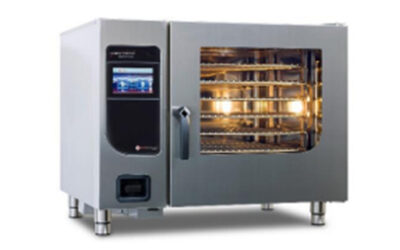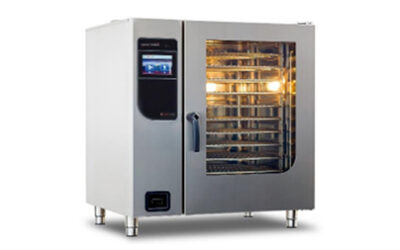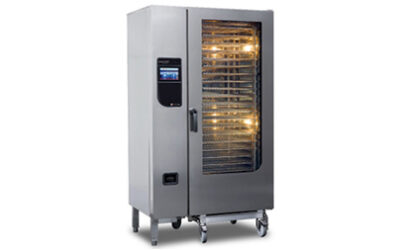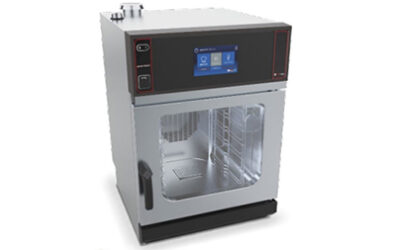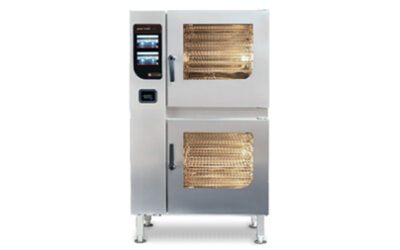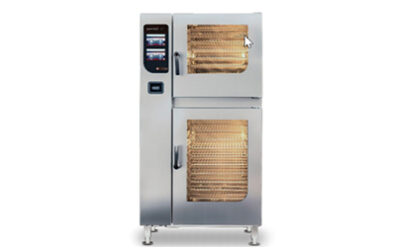Electric,...
Combi Ovens
Commercial Combi Ovens
Today’s commercial kitchens are changing rapidly, with the need for labor savings and efficiency more critical than ever. Continually expanding menus, fast-paced demand and evolving customer tastes are making Combi Ovens a powerful alternative to traditional steamers.
What Is a Combi Oven?
Also referred to as a “combination oven”, Combi Ovens use both moist and dry heat, either separately or in unison, to cook a variety of foods in many different ways. This inherent versatility means that a single piece of equipment can replace your steamer, grill and convection oven so you save tons of kitchen space.
Add in features like the FlexiRack racking system, boilerless DynaSteam2 and simple WaveClean cartridge and you’re armed with the innovation you need to maximize your kitchen operations.
Henny Penny’s Combi Oven solutions are designed with ultimate efficiency and performance in mind to help commercial kitchens like yours better utilize valuable floor space while maximizing ROI:
- Fast flexible cooking for a large variety of menu items
- Cook with combinations of moist and dry heat
- Easy-to-use oven controls enable precise recipes time after time
- Improved reliability, lower maintenance costs and longer useful life
- Maximum capacity and ease of loading

Click on each section below to take a more in depth look at Combi Ovens and how they can transform your commercial kitchen.
The Benefits of a Commercial Combination Oven Electric vs. Gas Combination Ovens
When it comes to deciding between an electric or gas Combi Oven, the choice really comes down to price and utility availability. Purchasing an electric Combi Oven is more suitable if:
- • You are in a higher elevation which limits the performance of gas equipment
- • Price is an issue. Electric models are generally less expensive than their gas counterparts, making them more affordable.
Purchasing a gas Combi Oven is more suitable if:
- • You are interested in greater efficiency. Current gas models are generally upwards of 50% more efficient than the top electric versions on the market
- • Speed is important. Open burner models directly transfer energy and increase temperature instantly.
Keep in mind that even if you have a gas model, an electrical connection will still be required to run digital displays and fans on most models.
Three Modes of Cooking: Steam, Convection and Combination
A commercial Combination Oven features three cooking methods in one appliance: steam, convection, and a combination of steam and convection.
Steam Mode
The steam mode in a Combi Oven uses steam to create a moist heat that keeps products juicy during the cooking process. It is ideal for steaming and poaching delicate items like seafood and vegetables so they have the perfect texture.
Convection Mode
With the convection mode, hot air is forced around the oven cavity, just like in a convection oven, creating a dry heat that browns foods and removes moisture in the cooking process. It is a great choice for baking, oven frying, and roasting foods like pizza, cookies and French fries.
Combination Mode
In combination mode, hot air and steam combine to cook foods without losing moisture. It is an excellent choice when you want to stew or braise foods. Meats and veggies come out tender and juicy, but with the browning you might expect in a convection oven. Certain breads can also be baked in this mode, where the steam helps to establish a hard crust.
The Benefits of a Commercial Combination Oven
Versatility: Maximize Your Kitchen Space
As many commercial kitchens are small, operations with limited space can benefit from a Combi Oven’s cooking flexibility. Combi Ovens eliminate the need to own, operate and maintain multiple pieces of hardware, as this versatile all-in-one appliance replaces your steamer, grill, griddle, fryer and convection oven. The enables you to prepare a wide range of dishes in one unit, with the versatility to easily roast, steam, smoke, poach, braise, grill or dehydrate food with precision and consistency.
Consistent Results: Reduce Food Waste
Higher productivity and consistency are essential to reducing food waste and spoilage. Compared to conventional ovens, Combi Ovens ensure you get the full bang for your buck. The menu possibilities and portion variations are endless, and the hassle-free controls also prevent shrinkage.
Precision Controls: Maintain Moisture and Quality
Combi Ovens come with the advantage of precision control over temperature and humidity. Users can control the exact combination of steam or heat with pre-programmable controls and easy-to-use touch screens. These controls ensure that food quality and taste remain consistent no matter who is cooking.
Time and Labor Savings: Advanced Cleaning Systems
Digital Combi Ovens offer another perk that commercial kitchens can use to their advantage. The automatic cleaning process of this versatile appliance saves time and labor by eliminating the need for manual scrubbing and cleaning, as well as reducing water usage. With “set it and forget it” features the oven virtually cleans itself, allowing you to focus your staff on other tasks.
Cost Savings: Energy Efficiency
Energy efficiency is another way a Combi Oven can benefit your foodservice operations. As Combi Ovens cook faster than conventional ovens, this leads to lower energy costs in the long run. Energy bill savings are put back into your operations for other resources, making a valuable difference in generating sustainable profits.
Greater Yield: Double Production Outcomes
Combi ovens are not one-size fits all. These commercial appliances come in various models and functions to fit the needs of your current foodservice operations. From countertop models to free-standing floor models you can cook more food in less space for significant operational advantages.
Combi Oven Size Considerations
The footprint of your kitchen, your anticipated volume and how you plan to use your oven all directly impact what size Combi Oven you will want to select. There are typically three sizes, which range from compact to roll-in units.
Mini
These pint-size ovens carry a significant impact when deployed in the right circumstances. They typically have no more than six shelves and accommodate between 3 – 5 pans.
Tabletop
For lower volume operations like quick-service restaurants or food trucks, you can take advantage of the modest, yet effective, space provided by tabletop models. These ovens generally have 6 – 12 shelves for half-size sheet pans and full-size hotel pans.
Floor Models
When you operate a high-volume kitchen that depends on preparing a lot of product and meeting high quality standards, you need a dependable oven with plenty of space. Floor model Combi Ovens have at least 20 shelves for holding 10 full-size sheet pans or 40 hotel pans.
Some manufacturers offer additional solutions such as the Henny Penny FlexiRack series of Combi Ovens. These ovens give you the ability to use specially designed pans and trays that enable you to take advantage of 50 – 100% more capacity. By optimizing the space in the cooking chamber, you can cook more food in less space for better operational savings.
Combi Oven Maintenance and Cleaning
Taking the time to clean and maintain your Combi Oven will save you money in the long run as regular maintenance will keep your equipment operating more effectively, longer. Here are some considerations to keep in mind.
Maintenance
- • Have your Combi Oven serviced every 6 months
- • Frequently check that the drain screen is in place. Without a drain screen bits of food can build up and block your drain.
- • Clean and lubricate door seals for proper door sealing.
- • The water that is fed into the Combi Oven should always be treated with a filtration system. This will slow the build-up of mineral deposits in the unit’s water lines. It will also reduce the build-up of scale on the oven’s heating units, water probes and cooking chamber to keep it operating as efficiently as possible.
- • Cleaner water also provides improved food taste. Check the manufacturer recommendations to find the right filtration system for your oven.
- • Replace your water filter every 3 – 6 months, depending on the oven’s usage.
Cleaning
- • Always check the manufacturer instructions before cleaning as each Combi Oven is different and instructions may vary from model to model.
- • Most Combi Ovens have self-cleaning features that use tablets or liquid detergents. Be sure to check your Operator’s Manual for manufacturer recommendations on the types of cleaners to use with your oven.
- • Avoid using abrasive cleaning equipment such as steel wool, scourers, and wire brushes to clean your Combi Oven as it can damage your equipment.
- • Make sure to clean the food probe frequently for proper sanitary practices.
- • Wipe your Combi Oven clean with a non-abrasive sponge before putting it through a cleaning cycle.
FAQ
How does a Commercial Combination Oven work?
A Combi Oven is, as the name implies, a “combination” oven. Combi Ovens typically include both convection fans and steam injection, along with precise control of temperature, humidity, and convection fan speed. It’s these factors that give chefs precise, predictable and powerful control over the way food cooks.
Is there a particular type of menu item that cooks best in a Combi Oven?
One of the biggest benefits of a Combi Oven is the wide variety of products that it can cook effectively. It allows proteins to cook faster and with more moisture, allowing the food to maintain its moistness. It enables operators to cook baked goods in a moist environment. It can also cook different foods in the same chamber, at the same time, without flavor transfer between items. It is a product truly rooted in versatility, waste reduction and quality all in one footprint.
What are restaurants most often using Combi Ovens for?
The flexibility of the Combi Oven makes it beneficial for the cooking of a variety of menu items at a variety of different types of restaurants. Fine dining to QSR restaurants can benefit from Combi Oven effectiveness. QSR restaurants, for example, see the value in using Combi Ovens to cook large amounts of one protein like bacon, which has large product variability, but requires consistent quality in a fast-paced environment.
In what areas does a Combi Oven lead to cost savings?
- • Reduced food waste as a result of more consistently cooked product
- • Higher yield on proteins due to less shrinkage
- • Shorter cook times resulting in energy savings
- • Higher productivity
- • More energy efficient than convection ovens
- • Ease of use/labor re-distribution
Is there a lot of training associated with Combi Ovens?
It doesn’t require a great deal of training to learn how to use a Combi Oven. An operator only needs to know the basics of what products lend themselves to each of the three cooking modes – steaming, convection and Combi cooking. Most of the training on the actual equipment is centered on developing and programming recipes into the Combi Oven. Once these recipes are established, it is as easy as selecting a product photo and hitting “go”.
Additional Resources
Watch >> Combi Oven Unique Features
Advantages of Adding a Combi Oven to your Operations
The Ultimate Guide to Henny Penny FlexFusion Combi Ovens: Features, Benefits and Tips
Achieving Consistent Food Quality in a Commercial Kitchen
Three Tips for Better Combi Cleaning
Three Advantages of Adding a Combi Oven to Your C-Store: Profits, Flexibility, and Throughput
Looking to explore equipment options before you buy?
Schedule a demo in one of our fully-equipped commercial kitchens in Cleveland, OH; Cincinnati, OH; or Pittsburgh, PA.
What Sets Us Apart
DynaSteam2 Boilerless Steam Technology Saves Operating & Maintenance Costs
FlexiRack™ Optimizes Space Within Cooking Chamber
Multiple Cook Modes Make This an All-in-One Machine
WaveClean Automated Cleaning System Significantly Reduces Water Usage
Henny Penny Model FPE 115
Electric, FlexiRack
Henny Penny Model FPE 215
Electric, FlexiRack
Henny Penny Model FPE 621
Electric, PowerAdvantage
Henny Penny Model FPE 121
Electric, PowerAdvantage
Henny Penny Model FPEM 221
Electric, PowerAdvantage
Henny Penny Model FSEN 610
Electric, Space$aver
Henny Penny Model FPDE 615/615
Electric, FlexiRack
Henny Penny Model FPDE 115/615
Electric, FlexiRack
Henny Penny Model FSDH 610/610
Electric, Integrated Hood
How can we help you?
Welcome to Kappus Company! Our team is eager to answer your questions and provide personalized solutions for your business. Please help us understand your needs by completing the form below and we will be in touch as quickly as possible.

